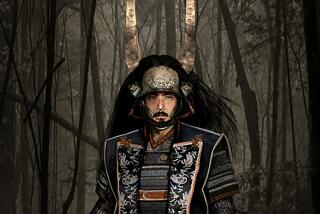DANCE REVIEWS : FLASHY JAPANESE REVUE
- Share via
Japan Week introduced some startling new uses of the past, Saturday at the Japan America Theatre in Little Tokyo.
On the same stage where, only last September, Tomijuro V and Hashinosuke III of the Grand Kabuki had danced the majestic “Renjishi” (Double-Lion), the all-girl Shochiku Kageki Dan company presented a rock ‘n’ roll version of the same classic.
In this opening number of a lavish 20-part dance revue imported from Japan, Kurara Hoshizato wore an approximation of Kabuki costume, and tossed a long white mane in an approximation of Kabuki style, while 10 lionesses in contemporary silver and scarlet pajamas lashed through an approximation of boogaloo moves from the Joey Heatherton go-go era.
Like this rock “Renjishi,” all the SKD transformations of Japanese cultural icons reflected a potent double vision: the original versions deftly evoked alongside (or within) their pop adaptations. And this sustained sense of a rich, living tradition proved intriguing enough to minimize the letdown caused by the rudimentary jazz choreography and rather slipshod show-dancing.
Unfortunately, when the production numbers turned to non-Japanese sources, the SKD Revue turned into camp of the most delirious sort. Consider “Hava Nagilah” performed by three bumping/grinding showgirls in silver-sequined leotards and net stockings, with enormous feathers cascading from their headdresses and shoulders. Where is Mel Brooks when we really need him? Where is the Jewish Defense League?
Consider, too, Tchaikovsky’s first piano concerto and the sacred Hindu dance-drama “Ramayana” chopped into cutesy showpieces. No cultural double vision here--merely monomaniacal kitsch relieved somewhat by the novelty of the company’s male impersonators.
Although there are men who wear as much makeup as the dancers cast as males in the SKD Revue (Michael Jackson, for instance), the intention here was obviously to look no more masculine than Marlene Dietrich did in her white-satin suit in “Blonde Venus.” Stiffly squared shoulders (a specialty of red-haired Kyoko Kai) and sharply articulated arm motion passed for a stylization of maleness but nowhere matched the Kabuki theater’s intricate, codified abstraction of femininity.
Among the leading dancers, Yoko Fujikawa looked first-rate in everything from the formal sword-and-halberd dance in “Tomoe” to the commanding central role in a version of Ravel’s “Bolero” that inventively developed correspondences between Spanish flamenco and Japanese odori. Even in the billowing fog of “Dojoji-Sho” and the blinding snowstorm of “Yuki-no-Tsugaru,” her skill and class shone brightly.
More to Read
The biggest entertainment stories
Get our big stories about Hollywood, film, television, music, arts, culture and more right in your inbox as soon as they publish.
You may occasionally receive promotional content from the Los Angeles Times.










